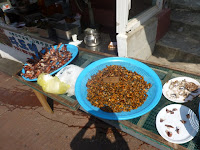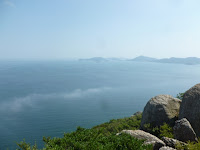Throughout the southwestern province of Jeollanam-do, the color green emanates in every hue, shade and tone imaginable. A hotbed for agriculture and rainy, humid weather, the land there soaks up every drop of moisture and transforms it into an emerald blanket, covering the fields and hillsides in simple but captivating beauty.
Arrival in Yeosu
My trip into Jeollanam-do began with an early morning bus ride from Daejeon to Yeosu, a port city jutting out into the Pacific from the southern coast of Korea. I stepped off the bus into a fairly quiet terminal and tried to get my bearings. After hopping on a city bus in the wrong direction for about 20 minutes, I somehow, eventually made it to my first destination for the day - Jinnamgwan.
Lacking in visual charisma, but making up for it in historical significance, Jinnamgwan was for many years a naval headquarters for by far the most important figure in the history of the region - Admiral Yi Sun-shin.
Commemorated through a brilliant golden stature just down the hill from Jinnamgwan, the admiral from the 16th century still holds a place of honor and respect in the hearts and minds of Koreans still today.
Odong-do
Following the harbor shoreline down via bus, I ventured over to my next stop - Odong-do. This small but tree-filled island is connected to the mainland by a cement causeway. It was definitely the first island I've ever walked to.
Dolson-do
As afternoon crept into Yeosu, it was my time to journey over to the other side of the harbor for some sunset views. The perfect place for this in the Yeosu harbor is on the adjacent island, Dolson-do. Connected by an elegant two-land bridge, Dolson is a rural contrast to the small but bustling port of Yeosu.
Immediately after crossing the bridge on foot, I looked up to see the steep green hill of Dolson park. After a brief but sweaty hike to the top, I looked out to see a panorama of the harbor area, lit by a fading orange sun.
The afternoon boats gradually coasted into their evening ports, as the glow of early evening arrived in Yeosu. It was time to begin my journey down the hill and back into town, for my rest at a local jjimjilbang.
Oops
Little did I know, that the one jjimjilbang I had selected for the evening was completely shut down. I arrived at this dismal conclusion after walking for about 45 minutes to other end of town, only to see a blacked out silhouette of what was once a 24 hour jjimjilbang. I concluded that I apparently didn't have the most recent version of the Yeosu tourist map, or August 1 was national Close Your Jjimjilbang for Tourists Day.
Well, it was about 10pm, and I needed a place to sleep. I asked a passing taxi driver for any other 24 hour jjimjilbang in the area, and he nodded his head. That was good enough for me, and I eventually arrived at what I was looking for, just on the other side of town at Suhyang Sauna. It didn't matter, because I was tired, and I needed rest for another busy day.
Hyangiram
After a surprisingly restful evening on top of a half-centimeter-thick mat, I jumped on a bus bound for the southern tip of Dolson-do. Far-removed from the urban jungles of Daejeon or Seoul, Dolson is a breath of fresh life, and Hyangiram is it's pinnacle. A coastal summer village comprised of vacation homes, seafood restaurants, and kimchi shops, all paths here lead up to Hyangiram hermitage - a serene Buddhist monastery located on an immaculate cliffside of the island.
Following the shaded stone paths, I passed through narrow walkways where the soft hymns of monks permeated through the trees.
Overlooking a vast, uninterrupted skyline of ocean, it seemed like everything about the design of this place revolved around this truly unbelievable view. Shrines and hallways, connected to one another by ancient paths open outward to a flawlessly blue sea.
This is a difficult place to leave behind.
Back to Yeosu
With the still-vivid images of Hyangiram and Geomosan pulsating in the back of my mind, the crowded by peaceful bus ride to Yeosu took me back across the Dolson bridge and into civilization once again.
As the sun, copying itself from yesterday, began to set once again on Yeosu, I walked along the harbor through fish markets and seaside stalls. The ocean is equal to life here - it's the center of industry, and the employer of so many who live in Yeosu. Seemingly every creature of the sea is up for sale at the local fish markets. What some may understandably confuse as an aquarium, the fish markets of Korea are meccas for food adventurers.
The freshness of the sashimi, along with the salty crunch of local kimchi made for quite a dinner. The side dishes included acorn jelly, anchovies, hard boiled eggs, and a couple other vegetables I truly could not recognize. It was all an incredible mixture of salty, fermented, fresh, and spicy flavors, all on one tray in front of me.
After dinner, I walked down the harbor to a coffee shop overlooking another bridge into Dolson-do. The sun finally set, and the lights of the harbor came to life. The glow of streetlights and the lit of bridges spanning the harbor illuminated a peaceful but active evening scene in Yeosu.
Off to Boseong
After another relaxing night at the jjimjilbang, I hopped on an early morning bus ride to Boseong, another Jeollanam-do town about 2 hours west of Yeosu, and the green tea capital of Korea.
The drive through the rural regions of the province revealed a hilly countryside dotted with farms and small towns, and green landscape everywhere in between.
Boseong is by far the smallest Korean towns I've visited so far, so when I got off at the bus terminal there (not much more than two parking spots and a bathroom), I was admittedly a little confused. I followed the Korean signs to a parking spot that said 녹차 밭 (green tea field). That was good enough for me, and sure enough, a bus arrived and took me to the largest green tea plantation in Korea, about 25 minutes outside of Boseong.
The green tea fields of Boseong were an enigma to me, because they were in such contrast to everything else I'd experience in Korea. There were tall pine trees. There were hiking paths that led to dense forests. And more than anything else, there were fields upon fields of terraced green tea plants, covering entire hillsides in glowing, shining green.
Even with some cloud cover, the vividness of the hillsides jumped out and completely captured the view. Pushing through the crowds of Korean tourists, I did eventually find some more isolated trails, winding through forest and terrace like a weave between natural habitats and human cultivation.
Almost any green tea-derived product you can imagine is for sale at the gift shop. I was satisfied to bring home just the tea itself, along with sampling some green tea noodles and ice cream for lunch. With a full stomach, a tired body, and a lighter wallet, it was a good time for me to start my bus journey back to Daejeon.
To me, Jeollanam-do was a recharging of my mind. It captured my senses through its colors, smells, and seaside culture. The memories of sapphire oceans and emerald fields will stay with me.
























No comments:
Post a Comment